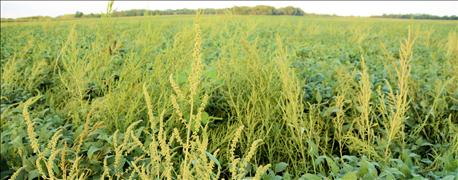
Illinois farmers know this to be true in 2016:
“Waterhemp will not only grow back on you, it’ll be meaner and uglier. And then you’ve got a sick weed that’s harder to kill,” says Benton farmer and Certified Crop Adviser Kelly Robertson.
For sure, waterhemp has been prolific across much of Illinois this year, thanks in part to wet weather that brought 13.74 inches on average across the state in July and August alone – more than 6 inches above normal, and the wettest July-August since 1915.

“A lot of our waterhemp problem is self-inflicted,” says Benton farmer and agronomist Kelly Robertson
But wet weather only tells part of the story, Robertson says. He speaks from experience; the southern part of Illinois has battled problematic and resistant weeds far longer than the rest of the state.
“Waterhemp is very particular about how you kill it,” he explains. “Our old problems – shattercane, cocklebur, jimpson weed – they didn’t care how you killed them. You could wave a jug of glyphosate at cocklebur and it would die.
“With waterhemp, you can’t get away with silly stuff,” Robertson continues. He believes farmers have created part of the problem with sloppy spraying and agronomic practices, like running a vertical tillage tool in the spring and then following up with a burndown. The problem? Vertical tillage doesn’t cut and chop the weeds. It mashes them over and tosses a little dirt on top. Injured plans don’t digest herbicide.
“Then you get a little rain, and that waterhemp realizes it’s still attached to the soil and says, ‘Hey, I’m going to grow,’” Robertson explains.
Robertson also thinks farmers have forgotten how to use residual herbicide – in particular, they don’t understand how soil pH affects residual activity. Soil pH can retard residual herbicide activity or cause hyperactivity, which can hurt the soybeans, depending on the chemistry you’re using.
“If your beans aren’t growing right, then you might have a problem with pH,” he says.
Measure resistance
But wait. Is your waterhemp just out of control or is it actually resistant?
It’s a solid question, says Karen Corrigan, agronomist with McGillicuddy Corrigan Agronomics. She says the only answer is to send off a sample for testing, which you can do for a $50 fee through the University of Illinois Plant Clinic.
“If it’s out of control, find out why. Send it in,” she says.
Corrigan says weather indeed wreaked havoc on 2016 spray plans. It was either raining and farmers couldn’t spray, then everything germinated and it was too late, or like last year, it was too dry and herbicides couldn’t activate.
In some cases, farmers used the wrong nozzles and didn’t get the best coverage with the herbicide they’d chosen. Others were spraying weeds that were too tall.
Robertson agrees and says farmers and waterhemp are the opposite of fishermen and fish: “When they tell the story, instead of the fish getting bigger, the waterhemp always gets shorter.”
Next year?
Given that waterhemp is a plant that can put out, without competition, 1,000,000 seeds per plant in its short life time, the question for many farmers is what to do about the disaster fields for next year.
Step one, says Robertson, is to not spread seed with the combine. Leave the waterhemp haven fields for last, and then thoroughly clean the combine to get it sterile for the next field.
“If you don’t, all you’ll do is load that combine up with waterhemp seed and scatter it all over the rest of the farm,” he says. Robertson treats Palmer amaranth the same way.
As for tillage, neither agronomist recommends changing what you’re already doing. Corrigan says if you put waterhemp seeds more than ½ to ¾ of an inch deep, they won’t come up next year; however, you’ll likely turn up other seed. Waterhemp is a tiny, hard seed shell and it can survive for years. “Even if you have 3% viable in the third year, that’s a fair amount of plants,” she says.
Corrigan and Robertson preach the same mantra: start clean and stay clean. If you intend to do tillage, Robertson says, you need to actually tear ground up; don’t use vertical tillage, because it won’t kill plants. “You want to kill weeds, not hide them,” he adds.
He also says to layer residual products, and per his previous comments, be sure you know your soil pH, so you’ll know what will and won’t work. Make sure you’re familiar with herbicide families – including brand names and traits – so you can compare and contrast what you’re using.
Rotating crops helps, including working in a wheat rotation if that’s possible. Corrigan says a lot of corn herbicides will take care of waterhemp, and most waterhemp shouldn’t be resistant to all pre-emergence herbicides - or to all chemistries (modes of action) of pre-emergent herbicides. Take the disaster fields into consideration though when going back to beans in two years, and consider different traited beans. Corrigan also recommends watching the headlands in fields next to your disaster fields, if they’re going to beans next year.
“Herbicides on fields with waterhemp is not the place to cut corners and save money,” she concludes.
For more on waterhemp, check out this publication from the University of Illinois, Iowa State University, University of Missouri and Purdue University.
About the Author(s)
You May Also Like






